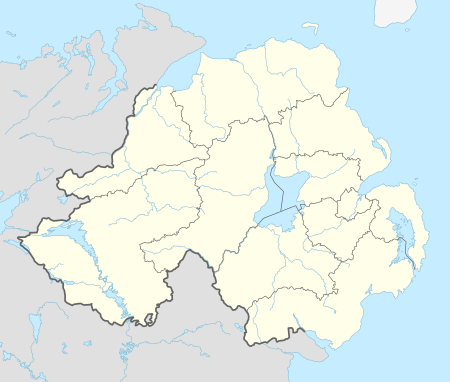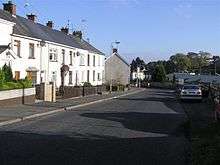1992 Coalisland riots
| 1992 Coalisland riots | |||
|---|---|---|---|
| Part of the Troubles and Operation Banner | |||
|
Confrontation between a British paratrooper and a local resident (May 1992) | |||
| Date | 12 and 17 May 1992 | ||
| Location |
Coalisland, County Tyrone, Northern Ireland 54°32′23.92″N 6°42′01.82″W / 54.5399778°N 6.7005056°WCoordinates: 54°32′23.92″N 6°42′01.82″W / 54.5399778°N 6.7005056°W | ||
| Causes | Provisional IRA attack on British army patrol near the village of Cappagh, County Tyrone | ||
| Result |
| ||
| Parties to the civil conflict | |||
| |||
| Casualties | |||
| |||
 | |||
| Another soldier lost his legs during the previous PIRA bomb attack at Cappagh | |||
The 1992 Coalisland riots were a series of clashes on 12 and 17 May 1992 between local Irish nationalist civilians and British Army soldiers (of the Third Battalion of the Parachute Regiment[1] and the King's Own Scottish Borderers) in the town of Coalisland, County Tyrone, Northern Ireland. The Third Battalion 1992 tour's codename was "Operation Gypsy".[2]
Provisional IRA attack
On 12 May 1992, a unit of the Provisional Irish Republican Army (IRA) East Tyrone Brigade launched a bomb attack on a British Army patrol near the republican stronghold of Cappagh, County Tyrone. One soldier of the Parachute Regiment, Alistair Hogdson,[3][4][5] lost both legs as a result. The landmine was described in an IRA statement as an "anti-personnel device".[6] The incident triggered a rampage by members of the Parachute Regiment in the nearby, overwhelmingly Irish nationalist town of Coalisland, some ten miles to the east.[6][7][8] The IRA attack was described as a "provocation" tactic, devised to produce an over-reaction by troops to make them even more unpopular among local nationalists.[9]
The deployment of the paratroopers, which began in April[1][10] had already been criticised by republican activist and former Member of Parliament Bernadette Devlin McAliskey, who denounced beatings, shootings and damages to property reportedly carried out by the troops.[11] These previous incidents included the destruction of fishing boats and equipments in the townland of Kinturk, near Ardboe.[11] Unionist politician and Ulster Defence Regiment officer Ken Maginnis, then-Member of Parliament for the area, called for the withdrawal of the regiment after receiving a large number of complaints about their behaviour.[6][12]
The confrontation
12 May
Two hours after the IRA attack, members of the regiment sealed off the town of Coalisland, ten miles east of Cappagh. According to a Social Democratic and Labour Party politician,[6] the soldiers fabricated a bogus bomb warning, while the Royal Ulster Constabulary (RUC) stated that the operation began when a joint police/military patrol was stoned by a crowd.[6][13] Two pubs were ransacked by the troops[14] and a number of civilian cars were damaged. Several people were allegedly hit with sticks. Following this, a lieutenant was suspended from duty[6] and the regiment was removed from patrol duties in Coalisland.[15]
17 May
On the evening of 17 May, a fist-fight began at Lineside Road, where a group of young men were having a drink. A passing four-man patrol of the King's Own Scottish Borderers (KOSB) regiment was challenged to a 'boxing match' by the residents.[11] The soldiers set aside their weapons and engaged the youths. Injuries were reported on both sides, none critical. The official claim was that the patrol was attacked by a mob[15] of at least 30 people.[16] In the melée, a rifle and a light machine gun were stolen. The rifle was later recovered nearby.[15] The youths smashed a backpack radio which had been left behind by the troops.[17] Two KOSB soldiers were hospitalised.[6]
The Parachute Regiment was called to the scene again, and at 8:30 PM, a major riot started outside The Rossmore pub[15] between local people and about 20 to 25 paratroopers.[11] The soldiers claimed one of their colleagues was isolated and dragged by the crowd. Some witnesses claimed paratroopers were in a frenzy, showing their guns and inviting civilians to try to take them. Suddenly, shots were fired by the troops —first into the air and then towards the people outside the pub. Three civilians were rushed to hospital in Dungannon with gunshot wounds, while the soldiers returned to their barracks.[15] Another four civilians suffered minor injuries.[14] One of the wounded was the brother of IRA volunteer Kevin O'Donnell, who had been killed by the Special Air Service in February during an ambush at the nearby hamlet of Clonoe, shortly after carrying out a machine-gun attack on the local RUC base.[17]
Aftermath

About 500 people attended a protest rally in Coalisland on 19 May, and the wisdom of deploying the troops to patrol the town was questioned by members of the Dáil in Dublin. The Minister for Foreign Affairs of the Republic of Ireland, David Andrews, asked the British Government to withdraw the regiment. As a result, the paratroopers were redeployed outside the urban areas.[18][19] The RUC claimed that the stolen machine gun was found 11 days later at Cappagh, along with another light machine gun and an AK-47 rifle.[20] Republicans questioned whether the weapon had really been stolen, suggesting this was merely an excuse for the soldiers' rampage in Coalisland.[11][17] British officials accused Sinn Féin of being the instigators of the riots,[13] while Michael Mates, then Minister of State at the Northern Ireland Office, stated that the incidents were due to "a gang of thugs motivated by the IRA".[21] Eventually the battalion's 1992 tour in Northern Ireland was scaled down, with the patrols suspended before the official end of the deployment. The Third Brigade's commander, Brigadier Tom Longland[10] was replaced by Brigadier Jim Dutton.[14][19][22][23][24] This was the first occasion that a high-ranking officer was disciplined in such a way during the Troubles.[25]
The last patrol took place on 27 June, when two paratroopers drowned while crossing the River Blackwater.[26][27] The same day, there were further clashes with local residents, this time in the town of Cookstown.[28]
Six soldiers faced criminal charges for their roles in the May riots,[14][29] but were acquitted one year later. Five were bound over.[30] Maurice McHugh, the presiding magistrate, averred that the soldiers were "not entirely innocent", while Sinn Féin sources dubbed the ruling "a farce". Dungannon priest Father Denis Faul was of the opinion that the soldiers should have been charged with conspiracy.[8] Authors Andrew Sanders and Ian S. Wood[25] suggested that the deployment of the battalion in Coalisland and elsewhere hindered the British policy of police primacy in Northern Ireland.[25]
See also
Online references
- Photo of Coalisland residents demonstrating outside the local RUC barracks, 19 May 1992
- Photo of Northern Ireland GOC Lt Gen Sir John Wilsey visiting troops deployed outside Coalisland, 19 May 1992
Notes
- 1 2 The economist, Volume 323, Issues 7761-4
- ↑ British Army 1945 on locations and dates
- ↑ Alistair Hogdson profile, mirror.co.uk; accessed 3 December 2015.
- ↑ Cumbrian amputee claims skydiving honour BBC News, 14 January 2010
- ↑ Reynolds, David (1998). Paras: an illustrated history of Britain's airborne forces. Sutton, p. 197; ISBN 0750917237
- 1 2 3 4 5 6 7 "New Paratroop controversy", emigrant.ie, 18 May 1992.
- ↑ "British troops launch charm attack in Belfast", by Peter Millership, Reuters, 8 August 1993.
- 1 2 McKittrick, David. "Coalisland 'soldiers not entirely innocent': Five paratroopers bound over by court", independent.co.uk, 18 May 1993; accessed 17 January 2015.
- ↑ Drake, C.J.M. (1998). Terrorists' Target Selection. Palgrave Macmillan, p. 41; ISBN 0-312-21197-X
- 1 2 Irish America (1992), Irish Voice, Inc., volume 8
- 1 2 3 4 5 "British army terrorises Irish town", Greenleft.org, 1 July 1992.
- ↑ Kennedy-Pipe, Caroline (1997). The origins of the present troubles in Northern Ireland. Longman, pg. 164; ISBN 0-582-10073-9
- 1 2 Wood, Ian S. (1994). Scotland and Ulster. Mercat Press, p. 161; ISBN 1-873644-19-1
- 1 2 3 4 CAIN −1992 chronology
- 1 2 3 4 5 Fortnight issues 302-12, Fortnight Publications, 1992, p. 6
- ↑ Alsing-Børgesen, Kai (1993). The Lift: Basisbog for Hf Og Gymnasiet. Gyldendal Uddannelse, p. 134; ISBN 8700106984
- 1 2 3 McAliskey, Bernardette (1992). The Moral of Coalisland. Spare Rib (issues 231–39), p. 47
- ↑ The Irish Emigrant, "Paratroopers remain in North". Issue No. 277, 25 May 1992
- 1 2 Wood, Ian S. (1994). Scotland and Ulster. Mercat Press, p. 61; ISBN 1-873644-19-1
- ↑ Fortnight, issues 302-12, Fortnight Publications, 1992, p. 24
- ↑ House of Commons, Thursday, 21 May 1992
- ↑ Brigadier Longland replaced by Brigadier Dutton, standard.co.uk; accessed 17 January 2015.
- ↑ Bew, Paul (1999). Northern Ireland: a chronology of the troubles, 1968–1999. Gill & Macmillan, pg. 260; ISBN 0-7171-2926-8
- ↑ McLeod, Alexander."British Take Paratroopers Off Ulster Security Detail", The Christian Science Monitor, 28 May 1992
- 1 2 3 Sanders, Andrew (2012). Times of Troubles: Britain's War in Northern Ireland. Edinburgh University Press. p. 198. ISBN 0748646566.
- ↑ Operation Banner Deaths: Roll of Honour, operationbanner.com; accessed 17 January 2015.
- ↑ Fortnight, issues 302-12, Fortnight Publications, 1992, pg. 22
- ↑ CAIN – Listing of Programmes for the Year: 1992 – UTV news, 27 June 1992, cain.ulst.ac.uk; accessed 17 January 2015.
- ↑ The Independent, 29 September 1992
- ↑ Fortnight, Issues 324-34, Fortnight Publications, 1994
